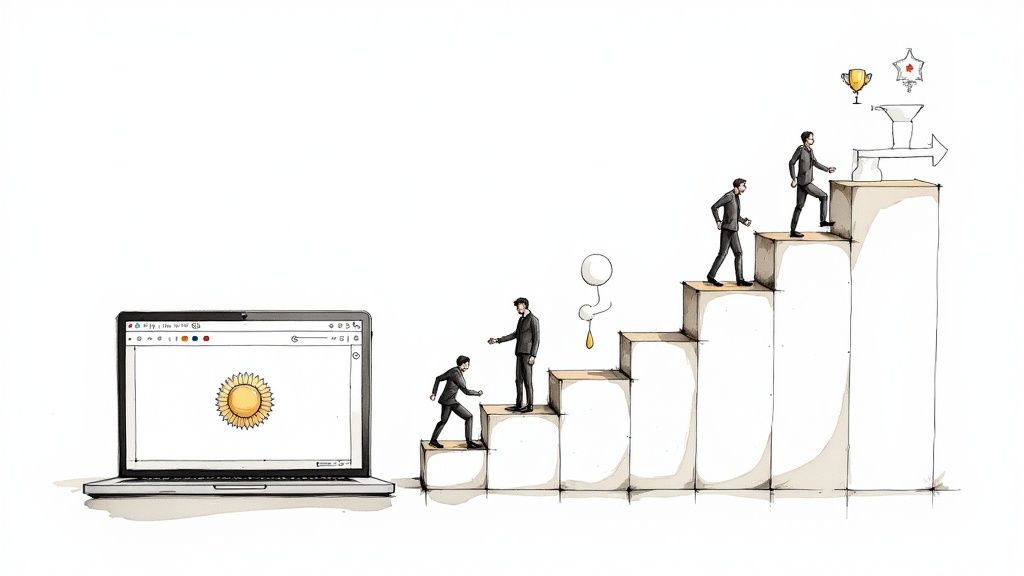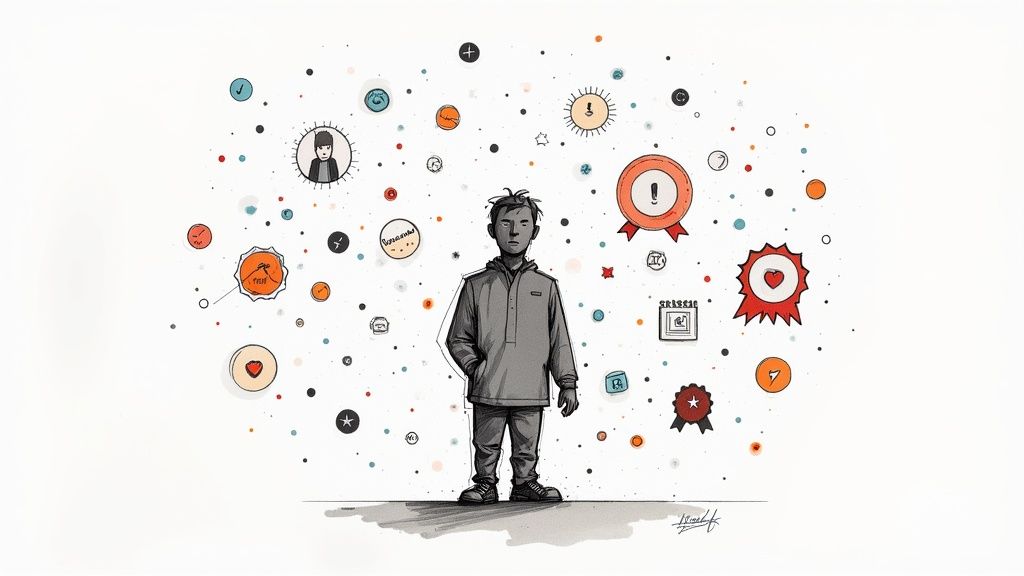
Gamification in Corporate Training That Works
Let's be honest—most corporate training is pretty forgettable. That's where gamification completely changes the game. It’s not about letting employees play video games on the clock; it's about tapping into our natural drives for achievement and competition to make corporate learning and development stick. The goal is to create training experiences people actually want to complete.
Why Gamification Is Reshaping Corporate Training
The biggest problem with traditional corporate training? Engagement. Or rather, the lack of it. Sitting through long presentations or scrolling through dense manuals just doesn't work for most employees. Information goes in one ear and out the other, and motivation tanks. Employees end up just clicking through modules to check a box, absorbing next to nothing. This is the engagement crisis modern learning and development (L&D) teams are up against.
Gamification hits this problem head-on by sprinkling game-like elements into the corporate training process. Think about what makes a game so addictive: you have clear goals, you get instant feedback, you can see your progress, and you get a rush from beating a challenge. By weaving these same mechanics into corporate training, you can turn a tedious requirement into an active, rewarding experience.
The Psychology Behind Engagement
At its core, gamification works because it speaks directly to our human psychology. When you earn points, unlock a new badge, or watch your name climb a leaderboard, your brain releases a little bit of dopamine—the chemical linked to pleasure and motivation. This creates a positive feedback loop that makes you want to keep going.
Gamification turns mundane training tasks into compelling challenges by tapping into our innate desires for competition, achievement, and social recognition. This shift from passive consumption to active participation is the key to unlocking genuine skill development and long-term knowledge retention.
If you're curious to dig deeper into this, there's some fascinating reading on the science behind how play transforms learning. It really breaks down why a well-designed gamified system can feel less like work and more like a personal quest for mastery.
Bridging the Gap Between Potential and Practice
The results are hard to argue with. A staggering 90% of employees feel that gamification makes them more productive at work. But here’s the disconnect: despite that enthusiasm, 43% of employees say they haven't seen any gamification in their own workplace training.
That gap is a massive opportunity for L&D leaders. Bringing in game mechanics isn't just a fad; it's a proven way to drive better business outcomes. And when you pair it with modern tools like interactive video, the possibilities for corporate training really open up. You can learn more about the benefits of investing in interactive video for training and see how perfectly it complements a gamified strategy. By making learning more dynamic and fun, companies can build a culture where employees are genuinely excited to learn new skills.
The Real Business Impact of Gamified Training
Let's shift from theory to practice. Gamification is so much more than a buzzword or a cheap trick to make training "fun." It's a strategic way to drive real, tangible business results. We're talking direct impacts on performance, engagement, and even how long your best people stick around.
When you do it right, gamified corporate training creates a powerful engine for skill development that shows up right on the bottom line.

The impact starts with how our brains actually work. Think about traditional training—it often leads to what psychologists call cognitive overload. People get swamped with too much information at once, and most of it goes in one ear and out the other.
Gamification flips the script. It breaks down complex topics into bite-sized challenges, which is a far more effective way to lock in new knowledge.
Boosting Knowledge Retention and Application
One of the biggest wins with gamification is how it affects memory. Game mechanics like instant feedback and spaced repetition aren’t just for fun; they're grounded in cognitive science and are proven to reinforce learning as it happens.
Picture a sales trainee learning about a new product. Instead of just reading a PDF, they're playing through a series of quick challenges in an interactive video. If they get an answer wrong, the system immediately corrects them and explains why. This solidifies the right information before bad habits can even form.
This active approach means employees are applying knowledge, not just passively consuming it. The result? A team that not only remembers what they were taught but can actually use it in their day-to-day work.
Fostering Healthy Competition and Collaboration
Leaderboards, team challenges, and shared goals inject a powerful social element into corporate training. This taps into our natural desire for recognition and achievement, turning what was once a solo slog into a group effort.
And this isn't about creating a cutthroat, dog-eat-dog workplace. It's about building a sense of shared purpose.
A well-designed gamified system turns skill acquisition into a shared mission. When teams work together to climb a leaderboard or unlock a group reward, they build camaraderie and reinforce a culture of continuous improvement.
For example, a customer service department could compete in teams to get the highest scores on a new de-escalation training simulation. This naturally encourages people to coach each other and share tips so the whole team can succeed.
Creating a Safe Space for Practice and Failure
Real growth requires practice, and practice inevitably involves making mistakes. But in many high-stakes roles, practicing on the job is risky, expensive, or both.
Gamified corporate training gives your team a safe, simulated environment where they can experiment, fail, and learn without any real-world consequences.
This "safe-to-fail" space is absolutely critical for building both confidence and competence. An engineer can run through a complex diagnostic procedure in a gamified simulation. A new manager can navigate tricky conversations using a branching scenario in an interactive video—something easily built with a platform like Mindstamp, which allows customers to create engaging, interactive learning and training content.
Being able to practice without fear just flattens the learning curve. It ensures people are truly prepared when they face these situations for real. For the business, that means fewer errors, better safety compliance, and stronger performance across the board.
Ultimately, all of this translates into stronger employee loyalty. When you invest in training that's actually engaging and effective, it sends a clear message: we value your growth. A recent survey found that 69% of employees are more likely to stay with a company for over three years if gamification is part of their training.
The North American market, which holds a 42.97% share of global gamification adoption, has been a leader in making this connection. You can dig into more insights on these trends in this SafetyCulture training report.
The Core Mechanics That Make Training Engaging
To really get what makes gamification in corporate training tick, you have to look under the hood at the specific mechanics that actually hook employees in. This isn't just about slapping a score on a quiz and calling it a day. It's about thoughtfully picking and mixing elements that tap into our core human drivers—things like achievement, competition, and the simple satisfaction of making progress.
Sure, points, badges, and leaderboards are the classic trio, but a truly great gamified system goes deeper. It weaves together more subtle elements to build a genuinely compelling experience. These are the building blocks that turn a passive training module into an active learning journey.
This visual really nails how the core pillars of gamification—engaging mechanics, clear goals, and what motivates us—all lock together to create a powerful learning experience.

The big takeaway here is that these pieces aren't just standalone gimmicks. They need to work in concert, supporting specific learning objectives to get real, tangible results.
To better understand how these mechanics translate into practical training tools, let's break down some of the most common elements. Each one taps into a specific psychological trigger to encourage a desired behavior or learning outcome.
Gamification Mechanics and Their Training Applications
These examples show that when you tie a specific game mechanic to a clear training goal, you're not just making learning fun—you're making it more effective.
Beyond Points and Badges
While points and badges are the foundation, they only work if they mean something. They have to represent a real accomplishment to have any impact.
Points are your most direct form of feedback. They put a number on effort and success, letting learners track their progress in a tangible way.
Badges are the visual proof of that success. Think of them less as participation trophies and more as symbols of mastery. That 'Cybersecurity Shield' badge? It’s a clear, recognizable sign that someone knows their stuff.
When done right, these simple mechanics build a sense of forward momentum that leads learners into more complex and rewarding parts of the training.
Progress and Mastery Visualized
Feeling like you're getting somewhere is one of the most powerful motivators out there. Gamified corporate training makes that feeling tangible and visible, which keeps people pushing forward.
A well-designed gamified training program makes progress impossible to ignore. By visualizing advancement through progress bars, levels, and skill trees, it provides a constant stream of positive reinforcement that encourages continued effort and skill development.
This is where visual feedback is so important. Progress bars filling up, or new levels unlocking more advanced content, give people a clear path. It breaks down what could be an overwhelming amount of information into small, manageable chunks, making the whole journey feel much more achievable.
Creating a Compelling Narrative
Storytelling is an incredibly powerful way to get people engaged. When you frame training inside a story, you give context and purpose to every task.
Instead of just learning compliance rules from a slide deck, employees could be on a "mission" to protect the company from a simulated cyberattack.
This narrative thread ties all the other mechanics together into a cohesive experience. Suddenly, completing a challenge doesn't just earn points—it moves the story forward. It turns learners from passive observers into the active heroes of their own development.
Instant Feedback and Safe Failure
In a lot of traditional corporate training, there's a huge delay between doing something and finding out if you did it right. You might take a quiz and not get the results for days, long after the learning moment has passed.
Gamification closes that gap with instant feedback loops. When a learner makes a mistake in a simulation or answers a question wrong, they find out right away. This is absolutely critical for fixing bad habits before they stick.
Platforms like Mindstamp are built for this. As an interactive video platform, Mindstamp allows customers to embed questions right into a training video that give immediate, personalized feedback. This creates a safe space for people to fail, experiment, and learn without any real-world consequences. When employees know it’s okay to try again, they’re far more willing to dive in and really engage with the material.
Building Your Gamified Training Strategy
So, you're sold on the mechanics. But how do you actually put them into practice? Building a truly effective gamified training program is more than just slapping some points and a leaderboard onto your existing content. It’s a thoughtful process that starts with crystal-clear goals and a genuine understanding of your team.
This is your roadmap, guiding you from a rough idea to a successful launch. Let's build something that’s not just engaging, but also lasts.

The first step? Ditch vague goals like "increase engagement." You need to define sharp, measurable learning outcomes. What specific skill or piece of knowledge should your employees walk away with? Your goals have to be concrete and tied directly to real business results.
Define Clear Learning Outcomes
Before you even dream about game mechanics, you need to know what winning looks like. Start by asking some tough questions that connect your training activities to tangible improvements on the job.
- What specific behavior are you trying to change? Maybe you want to reduce safety incidents, boost customer satisfaction scores, or shorten the sales cycle. Get specific.
- How will you measure this change? Pinpoint the key performance indicators (KPIs) you’ll track to prove the training is actually working.
- What knowledge gaps are holding people back? Identify the exact information employees are missing that’s preventing them from hitting those goals.
Once you have these outcomes nailed down, you can work backward to pick game mechanics that actually support them. This is how you ensure your gamification in corporate training has a real purpose, instead of just being window dressing.
Understand Your Audience's Motivations
Here's a reality check: not everyone is motivated by the same things. Your hyper-competitive sales team might go wild for a public leaderboard, but your collaborative engineering team might respond way better to group challenges and shared rewards. Figuring out what makes your employees tick is non-negotiable.
A successful gamification strategy speaks to the intrinsic and extrinsic motivators of its audience. By aligning game mechanics with what your employees truly value—whether it's recognition, mastery, or collaboration—you create a learning experience that feels personally rewarding.
You don't need a massive research project. Just run some simple surveys or have a few informal chats. Do they prefer individual praise or team wins? Are they driven by competition, or is the simple satisfaction of mastering a new skill enough? This insight is gold. It helps you tailor the experience for maximum impact, avoiding the one-size-fits-all approach that causes so many programs to fall flat.
Select the Right Mechanics and Theme
Alright, you know your goals and you know your people. Now it's time to assemble your toolkit. Think about the right game elements for the job. For a compliance module where accuracy is everything, instant feedback and points for correct answers are a perfect fit. For a leadership program, a branching narrative inside an interactive video might be a much more powerful tool.
The real magic happens when you weave these mechanics into a cohesive theme or story. Suddenly, the "Quarterly Security Update" becomes a "Mission to Defend the Digital Fortress." A strong narrative gives meaning to the points, badges, and challenges, turning a boring task into an actual quest.
This is where interactive video truly shines. With an interactive video platform like Mindstamp, you can use branching scenarios and in-video questions to bring a theme to life. The numbers back this up, too. Reports show corporate gamified training can lead to an 83% increase in employee motivation, with knowledge retention jumping by around 30% when visual game elements are involved. With nearly half of employees (49%) bored to tears by traditional training, this approach isn't just nice to have—it's essential.
Using Interactive Video to Gamify Learning
Let's be honest: static training videos are the new dusty textbook. Employees hit play, zone out, and remember almost nothing. But what happens when you mix the fun of gamification in corporate training with the power of interactive video? You get an active challenge that pulls learners in and makes the lesson stick. This is where gamification stops being a buzzword and starts being a real-world tool for L&D leaders.
Interactive video is how you bring game mechanics to life right inside your training content. Instead of just watching a video about new compliance rules, imagine your team making choices and answering questions that actually change the outcome of a scenario. Suddenly, they’re part of the story.
Turning Passive Viewers into Active Learners
The whole idea is beautifully simple: make the learner do something. Interactive video lets you break that passive stare-at-the-screen cycle by dropping in game-like elements that require a click, a choice, or an answer. This isn't just about making training "fun"—it's about tapping into the proven fact that people learn best by doing.
With a platform like Mindstamp, you don’t need a team of developers to make this happen. Mindstamp is an interactive video platform that allows customers to create engaging, interactive learning and training content. You can layer interactive features right onto your standard videos, turning them into dynamic, hands-on training modules.
- Embedded Quizzes: Drop multiple-choice or short-answer questions directly into the video. You can award points for right answers and offer instant feedback to clear up confusion right away.
- Clickable Hotspots: Ever played a "point-and-click" adventure? You can do the same here. Create scavenger hunts where learners have to find and click on important details in the video to earn points or unlock the next chapter.
- Personalized Feedback: Based on how someone answers a question, you can automatically send them to a specific video clip. If they get it right, reinforce the concept. If they struggle, offer a more detailed explanation.
This screenshot from Mindstamp’s site shows just how seamlessly an interactive menu can be layered right on top of a video, putting the viewer in the driver's seat.
As you can see, interactivity isn't some clunky add-on; it’s woven directly into the experience, giving learners the freedom to navigate and make choices.
Building Immersive Training Scenarios
Beyond simple quizzes, interactive video really shines when you build complex, branching scenarios. For skills-based training—like sales, customer service, or leadership—this is a total game-changer.
Think of it as a "choose-your-own-path" story for work. It simulates real conversations and tough decisions, giving employees a safe space to practice, fail, and learn without any real-world consequences.
Picture a sales training module where a new rep is facing a skeptical customer. The rep has to choose a dialogue option. One choice leads to a video scene where the customer is impressed and the deal moves forward. Another choice leads to a scene where the customer shuts down completely.
By working through these branching paths, employees don’t just memorize a script—they learn how to think on their feet and adapt. It's an immersive experience that traditional lectures or PDFs simply can't match. It puts the learner at the heart of the story and makes them an active player in their own development, which dramatically improves both retention and their confidence to use these skills on the job.
How to Measure the ROI of Your Program
So you’ve built an amazing, gamified training program. That’s a huge win. But sooner or later, a stakeholder is going to walk up to you and ask, "What was the return on our investment?" To have a great answer, you need more than just good feelings and anecdotes—you need cold, hard data.
Measuring the ROI of your gamification in corporate training isn't just about ticking a box or justifying a budget. It's about proving its real-world value to the business. It’s about drawing a straight line from the points and badges your team is earning to a stronger, more capable, and more profitable company.
Key Performance Indicators for Gamified Training
To tell that compelling story, you'll need to collect data from three different angles. Each one gives you a unique piece of the puzzle, and together, they paint a full picture of your program's impact.
Learning Metrics: These are your ground-zero numbers. Did people actually learn what you needed them to learn? Track things like completion rates, assessment scores, and how quickly people reached proficiency. A great question to ask is: did the new gamified module get finished more often than the old, static PowerPoint?
Engagement Metrics: This is where you measure the buzz. How much did people want to participate? Look at your participation rates, how many times someone replayed a module to get a better score, and the total time spent on task. High engagement is almost always a leading indicator of better learning.
Business Metrics: This is the metric category that gets the C-suite's attention. Here's where you connect the training directly to business goals. Can you show a jump in productivity, a drop in on-the-job errors, or a decrease in employee turnover? What about customer satisfaction scores? These are the numbers that really move the needle.
Proving ROI means showing a clear cause-and-effect. The goal is to say, "The employees who scored highest on this safety simulation also had a measurable drop in workplace incidents." That’s a connection no one can ignore.
Connecting Training Data to Business Outcomes
The final step is weaving all that data into a powerful narrative. For instance, maybe you can show that the salespeople who earned the "Advanced Product Knowledge" badge closed 15% more deals the next quarter. Or you could point out that the department with the highest participation in a gamified compliance course had 40% fewer policy violations last year.
The trick is to establish a baseline before you launch the program. That way, you can track the changes over time and clearly link specific training achievements to tangible performance boosts. It builds an undeniable case for your strategy.
If you want to go deeper on this, check out our complete guide on how to measure training effectiveness to get started. A data-driven approach doesn't just prove your program's success—it builds the trust and buy-in you need for all your future L&D projects.
Ready to transform your passive training videos into active, measurable learning experiences? With Mindstamp, you can easily embed quizzes, branching scenarios, and other game-like features to create training that truly sticks. Start your free trial today and see the difference interactive video can make.
Get Started Now
Mindstamp is easy to use, incredibly capable, and supported by an amazing team. Join us!



Try Mindstamp Free










